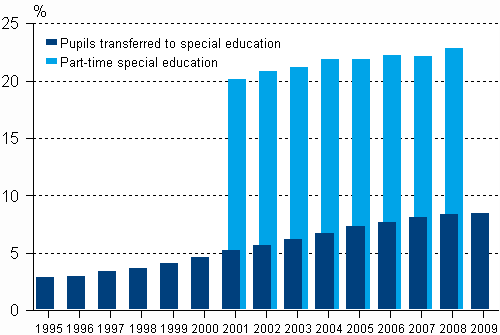Published: 11 June 2010
Number of pupils transferred to special education unchanged, more students in part-time special education
Eight-and-a-half per cent of comprehensive school students, or over 47,000 pupils, had been transferred to special education in autumn 2009. The number was almost unchanged from the previous year. Around 23 per cent, or 127,900 comprehensive school students, received part-time special education during the 2008-2009 academic year. The number of pupils attending part-time special education grew by 1,600 from the previous year. These data derive from Statistics Finland’s Education Statistics.
Shares of pupils transferred to special education and receiving part-time special education among all comprehensive school pupils 1995-2009, % 1)

1) Comparable data on part-time special education are available for the 2001-2008 period (year 2008 referring to the 2008-2009 academic year). The numbers of pupils transferred to special education and recipients of part-time special education cannot be added together because some of the pupils transferred to special education also receive special teaching part-time.
The share of pupils transferred to special education was highest in the regions of Päijät-Häme, South Karelia and Uusimaa, where it was at least ten per cent of all comprehensive school pupils. The number of pupils transferred to special education was lowest in the region of Åland. Compared with the number of pupils, the number of pupils receiving part-time special teaching was highest in the region of Etelä-Savo, nearly 27 per cent. No part-time special education was arranged in Åland.
In 2009, 29 per cent of those transferred to special education were fully and 24 per cent partially integrated into groups attending general education. In all, 33 per cent of those transferred to special education received teaching in special groups in comprehensive schools and 14 per cent in special schools. More often than in the previous year special education was arranged in general education groups and in special groups in comprehensive schools. Instead, the number of special pupils studying in special schools and partly in general education groups decreased.
During 2008, a total of 16,500 vocational education students received special teaching. Their number was one thousand higher than the year before. The share of special students was six per cent among all vocational education students and 13 per cent among those attending vocational education aimed at young persons.
Source: Education 2009. Statistics Finland
Inquiries: Riikka Rautanen (09) 1734 2375, koulutustilastot@stat.fi
Director in charge: Jari Tarkoma
Publication in pdf-format (222.2 kB)
- Tables
-
Tables in databases
Pick the data you need into tables, view the data as graphs, or download the data for your use.
Appendix tables
- 1. Comprehensive school pupils transferred to special education in 1995-2009 1) (11.6.2010)
- 2. Comprehensive school pupils transferred to special education by place of provision of special education in 2009 (11.6.2010)
- 3. Comprehensive school pupils transferred to special education by teaching arrangements in 2009 (11.6.2010)
- 4. Comprehensive school pupils transferred to special education by ground for decision of acceptance or transfer in 2009 (11.6.2010)
- 5. Comprehensive school pupils receiving part-time special education in the academic year 2008-2009 by primary reason for special education 1) (11.6.2010)
- 6. Special students in vocational education by place of provision of special education in 2004-2008 (11.6.2010)
Updated 11.6.2010
Official Statistics of Finland (OSF):
Support for learning [e-publication].
ISSN=1799-1617. 2009. Helsinki: Statistics Finland [referred: 19.4.2025].
Access method: http://stat.fi/til/erop/2009/erop_2009_2010-06-11_tie_001_en.html

